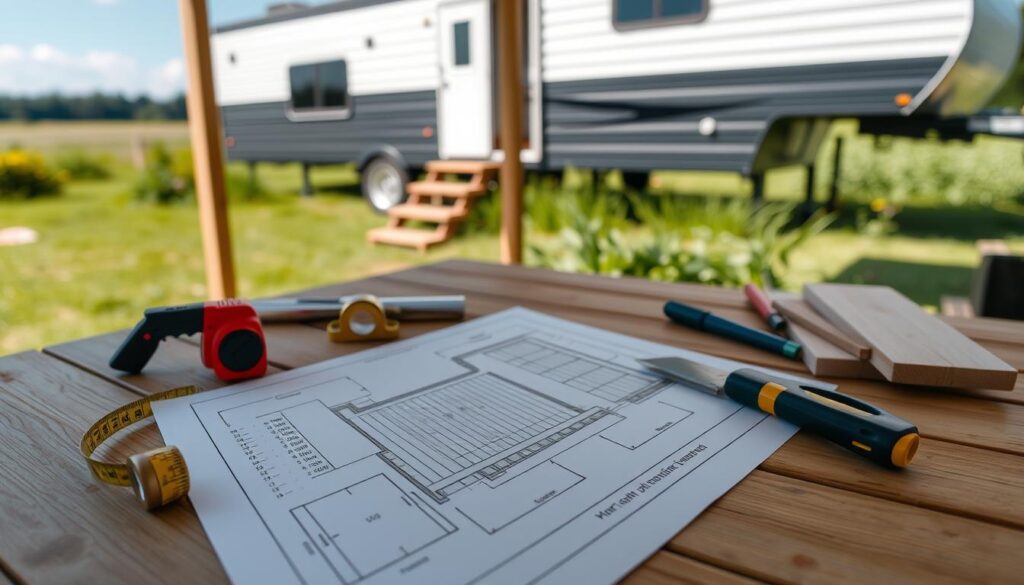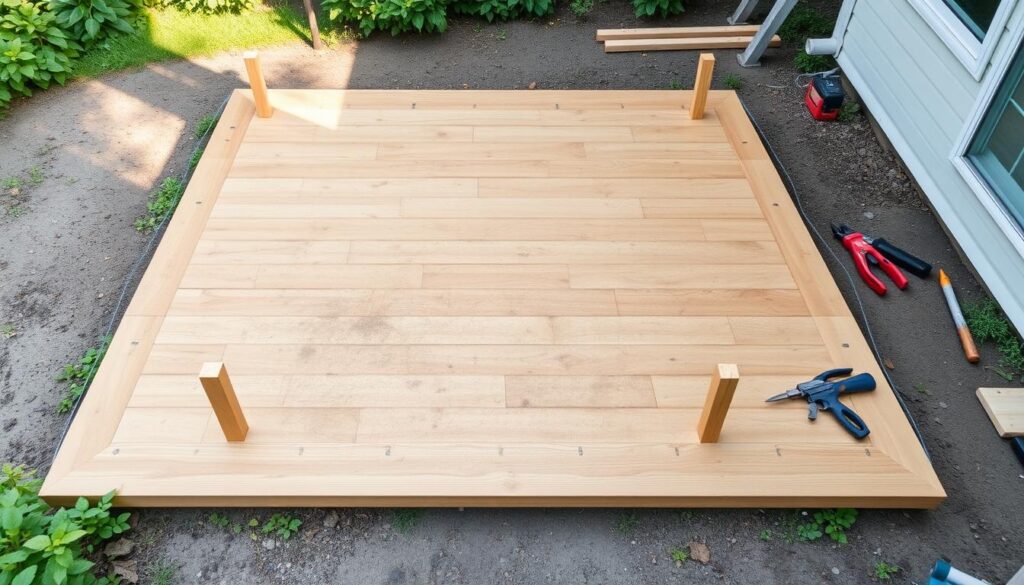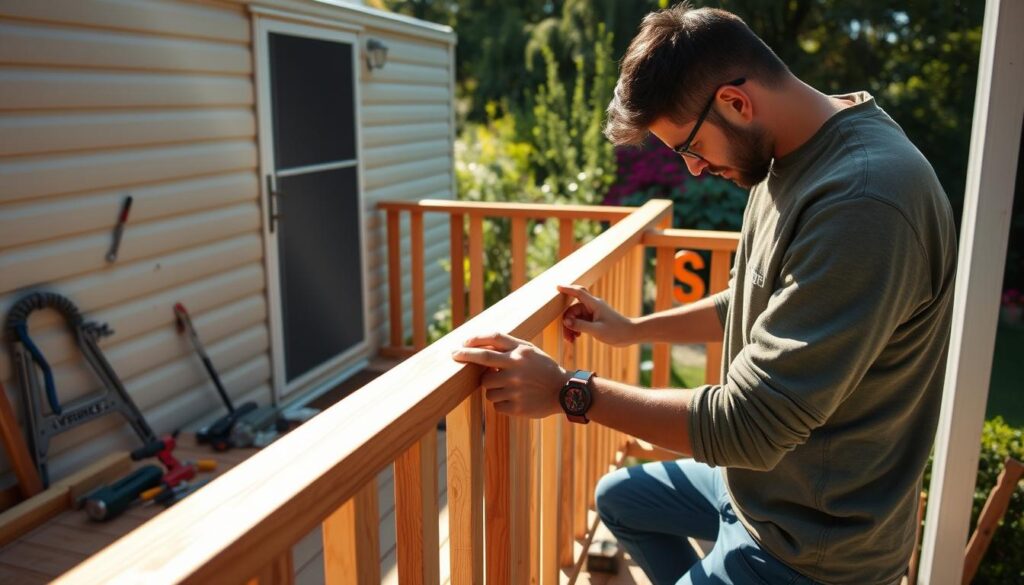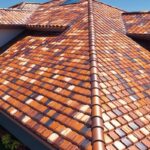Ever thought about turning your mobile home’s outdoor area into a cozy spot? Building a deck could be the answer. But can you do it yourself, even if you’re new to DIY projects?
A deck can make your mobile home’s outdoor space better, increase its value, and be perfect for outdoor fun. This DIY guide will help you plan and build a deck for your mobile home. It’s all about making your deck beautiful and useful.
With the right plan and effort, you can build a simple deck in a week or two. More detailed designs might need a pro’s help. But don’t worry, this guide has you covered from getting permits to picking materials and building it step by step.
Table of Contents
Key Takeaways
- Ground level decks are usually 12 to 30 inches high
- Composite decking is a low-care option with hidden fasteners
- You’ll need a circular saw, level, power drill, and post hole digger
- Right joist spacing and deck board placement are key for stability
- A 10×16-foot pressure-treated deck costs $800 to $1,000 on average
- Building it takes 4 to 6 days, plus time for concrete to cure
- Different decking materials have their own benefits and upkeep needs
Understanding Mobile Home Decks
Adding decks to trailer homes makes outdoor living better and increases property value. A well-made deck can change your mobile home into a great place for relaxing and having fun. Let’s look at the benefits, differences, and materials used in mobile home decks.
Benefits of Adding a Deck to Your Mobile Home
Decks bring many good things to mobile home owners. They make living spaces bigger, improve how your home looks, and can make you money when you sell. Wooden decks, for example, can return up to 87.4% of the cost when you sell your home. This makes them a smart choice for improving your home.
Differences Between Porches and Decks
Porches and decks both make outdoor living better, but they are different. A porch is usually covered or closed, keeping you safe from the weather. Decks, however, are open and built on the back of your home. They offer a space for fun and gatherings.
Common Materials Used for Mobile Home Decks
Choosing the right deck materials is key for lasting quality and easy care. Here are some popular choices:
- Pressure-treated pine: It’s cheap but needs regular care
- Ipe: A strong South American wood, but it’s pricey
- Cedar: It fights off rot well, perfect for open decks
- Redwood: It looks good and lasts long, but it’s expensive
- Composite materials: They’re made of wood and plastic, easy to care for
Each material has its own good and bad points. Think about your budget, the weather, and how much you want to care for your deck when picking materials for your mobile home.
Planning Your Mobile Home Deck Project
Deck planning for your mobile home begins with careful preparation. This is key for a successful deck project. Let’s look at the main parts of planning your deck.
Obtaining Necessary Permits and Approvals
Before starting, check local rules for building permits. Many places need permits for deck building, even for mobile homes. Reach out to your local building department to find out what you need. This makes sure your deck is safe and avoids legal problems.
Designing Your Deck Layout
Make a detailed plan for your deck. Think about its size, shape, and how it will connect to your home. Remember, decks should not be more than 20% of your home’s total square footage. Use online tools to see your deck design and make a list of materials.

Calculating Materials and Costs
Calculate your deck project’s cost carefully. Material costs for a mobile home deck are $11 to $70 per square foot. Labor costs, if you hire pros, can be $11 to $40 per square foot. The total cost usually ranges from $5,000 to $10,000, based on size and materials.
| Cost Component | Price Range (per sq ft) |
|---|---|
| Materials | $11 – $70 |
| Labor | $11 – $40 |
| Total Project Cost | $5,000 – $10,000 |
Good planning keeps your deck project on budget and meets your needs. With permits in hand, design set, and costs figured out, you’re ready to start your mobile home deck project.
Essential Tools and Materials for Deck Construction
Building a deck for your mobile home needs the right tools and materials. Having the right tools can make your project go smoothly or turn it into a headache.
A 25-foot tape measure is perfect for most deck tasks. For bigger decks, you might need a longer tape. Framing squares are key for accurate angles. The DeWalt Green Rotary Tough Laser, priced at $1600, is great for precise layouts.
Cutting tools are vital for deck building. You’ll need a circular saw and a jigsaw. For cutting beams, consider the Prazi 12-in. Beam Cutter at $140 or the Big Foot 10-1⁄4-in. Worm Drive Beam Saw at $360.
Fastening tools help speed up your work. An 18- or 20-volt cordless drill is ideal. The DeWalt 3⁄8-in. Right Angle Drill/Driver, priced at $130, is great for tight spots. For driving nails, the Bostitch StrapShot Metal Connector Nailer at $190 is efficient.
| Tool Category | Essential Items | Price Range |
|---|---|---|
| Layout and Measuring | Tape measure, Framing square, Laser level | $8 – $1600 |
| Cutting | Circular saw, Jigsaw, Beam cutter | $140 – $680 |
| Fastening | Cordless drill, Nail gun, Impact driver | $130 – $190 |
| Smoothing and Shaping | Router, Belt sander, Random orbit sander | Varies |
For deck materials, choose quality lumber and concrete for footings. Use stainless steel or hot-dipped galvanized fasteners for pressure-treated lumber. Composite decking and vinyl railings are good for less upkeep than wood.
Preparing the Site for Your Mobile Home Deck
Getting your deck site ready is key to a strong and lasting deck for your mobile home. It requires careful planning and action. This ensures your deck is built on a solid base.
Marking the Deck Area
Begin by marking the deck area with batter boards and mason’s lines. These tools help define the deck’s edge clearly. Use the 3-4-5 method to square the corners for accuracy. This method makes sure your deck fits perfectly with your mobile home.

Removing Sod and Leveling the Ground
If local codes demand it, remove the sod from the marked area. A sod cutter can simplify this task. Then, level the ground well to create a firm base for your deck. This step is crucial to avoid future structural problems.
Setting Up Batter Boards and String Lines
Put up more batter boards to mark where the posts will go. Use marking paint to show where to dig the post holes. This visual guide will be very helpful during the build. Don’t forget to mark the deck height on your mobile home. Make sure it’s below the door threshold for easy access.
Proper deck site preparation is the first step to a successful build. By carefully marking your deck layout and preparing the ground, you’re setting the stage for a beautiful and useful outdoor space. It will enhance your mobile home.
Building the Deck Foundation
Building a strong deck foundation is key for your mobile home. It begins with digging holes below the frost line. This depth varies by location, with Florida needing about 1 foot and Minnesota up to 8 feet. Always check local codes for specific requirements.
Next, put concrete tubing forms in the holes. Make sure they’re level, 1-inch above ground. Mix concrete and fill the forms. While the concrete is wet, add post anchor bolts, following your layout. These post anchors are crucial for securing your deck.
Let the concrete dry completely before attaching post bases to the anchor bolts. Keep the nuts loose for final adjustments. This ensures your deck foundation is perfectly level.
Deck footings are vital for supporting your structure. They can be 2-feet square or 2-feet in diameter. Their size depends on load-bearing needs, soil strength, and deck design. Remember, a deck with people can weigh thousands of pounds!
| Footing Type | Description | Best For |
|---|---|---|
| Buried Post & Footing | Post set directly in concrete | Simple, low-height decks |
| Tube Pier | Concrete-filled cardboard tube | Medium-height decks |
| Bell Pier | Wider base for better stability | High decks or soft soil |
| Pier & Footing | Separate footing and pier | Professional installations |
Before digging, call 811 or visit www.call811.com to mark underground utilities. This step prevents damage to sewer, water, gas, or electric lines when building your deck foundation.
Framing Your Mobile Home Deck
Deck framing is the core of your outdoor space. It’s essential for stability and lasting use. Let’s explore the main parts of deck framing.
Installing Support Posts
Support posts are the deck’s base. Cut them a bit taller than your deck will be. Place them firmly in bases and secure them well. This step is key for a strong deck that can handle weather.

Attaching Rim Joists and Beams
Rim joists and beams make up the deck’s outer frame. Attach rim joists to the support posts, ensuring they’re level. For flush beams, place them on post bases. Finish the deck frame with the rest of the rim joists. Remember to add angle brackets as needed by local codes.
Adding Interior Joists
Deck joists support the decking boards. Mark where to place joists on rim joists, usually 12, 16, or 24 inches apart. Install joist hangers, cut joists, and secure them. This step is vital for a deck that can handle people and furniture.
“Proper deck framing is like building a strong skeleton. It’s not visible once complete, but it’s what keeps your deck standing tall and safe for years to come.”
Following local building codes is key when framing your mobile home deck. Some places need decks to be separate structures, while others allow them to be attached. Always check with your local building department before starting your project.
Installing Decking Boards
Ready to start decking installation for your deck on trailer house? Let’s dive into the process. First, decide the direction of your decking boards. Most often, they run parallel to your home for a sleek look.
Start with the first board, leaving extra length on the ends. As you progress, keep a gap of 1/8 to 3/16 inches between boards. This spacing allows for proper drainage and prevents water buildup.
Secure each board with two fasteners per joist. Place these fasteners about 3/4 to 1 inch from the board edges for optimal strength. For larger decks, consider adding parting boards. These run perpendicular to the main decking, adding visual interest and allowing the use of shorter boards.
| Decking Material | Usage in DIY Projects | Average Cost (10×16 ft) |
|---|---|---|
| Composite | 35% | $2,000 – $3,500 |
| Pressure-Treated Wood | 45% | $800 – $1,000 |
| Cedar/Redwood | 20% | $1,500 – $2,500 |
Remember, proper decking installation is crucial for the longevity of your deck on trailer house. Take your time, measure twice, and cut once. With patience and attention to detail, you’ll have a beautiful, functional deck in no time.
Adding Railings and Stairs to Your Mobile Home Deck
Adding railings and stairs to your mobile home deck makes it safer and more attractive. We’ll look at how to pick the best options and follow building codes.
Choosing the Right Railing Style
Deck railings come in many materials and designs. Wood gives a classic feel, while metal is durable. Think about your home’s style and how easy it is to maintain when choosing. Also, remember to check local codes for height and spacing of balusters for safety.

Building and Installing Deck Stairs
Deck stairs are key for easy access. Make sure to calculate the rise and run carefully for comfortable steps. Wooden steps with railings for a mobile home can cost between $500 and $1,500. You can choose pre-built options or go for custom builds for more flexibility.
- Measure the height from the ground to the deck
- Determine the number of steps needed
- Install stringers and secure treads
- Add handrails on both sides if required
Ensuring Safety and Compliance with Building Codes
Following building codes is crucial for deck railings and stairs. Check local rules for stair width, tread depth, and railing height. Railings should be 36 to 42 inches high, with balusters no more than 4 inches apart. Proper installation not only keeps you safe but can also raise your mobile home’s value by up to 10%.
“Safety should never be compromised when it comes to deck construction. Always prioritize building code compliance.”
Finishing Touches and Maintenance for Your Deck
Your new mobile home deck is ready, but the work doesn’t stop there. Keeping your deck in good shape is important. Wood decks need care twice a year, while composite decks are easier to maintain.
Wood decks need regular cleaning. Use a gentle cleaner and a stiff-bristle brush, then rinse with a garden hose. Sealing and staining protect against moisture, UV rays, and wear. A well-maintained wood deck can last from 10 to 50 years, depending on the wood and treatment.
Composite decks are simpler to care for, needing only occasional cleaning. You can pressure wash them, but avoid using more than 3,100 psi. Deck finishing varies for different types, so always follow the manufacturer’s instructions.
Seasonal care is key for all decks. In spring and summer, check, fix, clean, and reapply sealant or stain as needed. Before winter, make sure your deck is ready for harsh weather.
| Deck Type | Maintenance Frequency | Lifespan | DIY Refinishing Cost (per sq ft) |
|---|---|---|---|
| Wood (Untreated) | Twice yearly | 10-30 years | $0.50-$0.65 |
| Wood (Treated) | Twice yearly | Up to 50 years | $0.50-$0.65 |
| Composite | Occasional cleaning | 25-30 years | N/A (minimal maintenance) |
Regular checks and preventive steps like using furniture pads and planters on stands can help your deck last longer. With the right care, your mobile home deck will be a great spot for outdoor fun for years to come.
Conclusion
Building a deck for your mobile home is a great way to improve your living space and increase your home’s value. The mobile home deck benefits are many, from creating an outdoor entertainment area to a relaxing spot for your family. DIY deck construction can be a rewarding project that adds both function and beauty to your home.
When starting this project, it’s important to check local regulations and building codes. Many places have specific rules for mobile home additions. These rules often require separate foundations and prevent attaching the deck directly to the main structure. This ensures your home’s safety and meets safety standards.
Keep in mind that while upgrades like decks can make your home more appealing, they might not always increase resale value much. It’s key to balance your investment with potential returns. If you’re thinking about moving in the future, remember that proper anchoring of your deck is vital for safety and following rules.
By following this guide and focusing on safety and quality in your DIY deck construction, you’ll add a lasting feature to your mobile home. Regular maintenance will keep your new deck enjoyable for years, making it a perfect spot for relaxation and outdoor living.








2 thoughts on “How to Build A mobile home decks? : DIY Installation Guide”